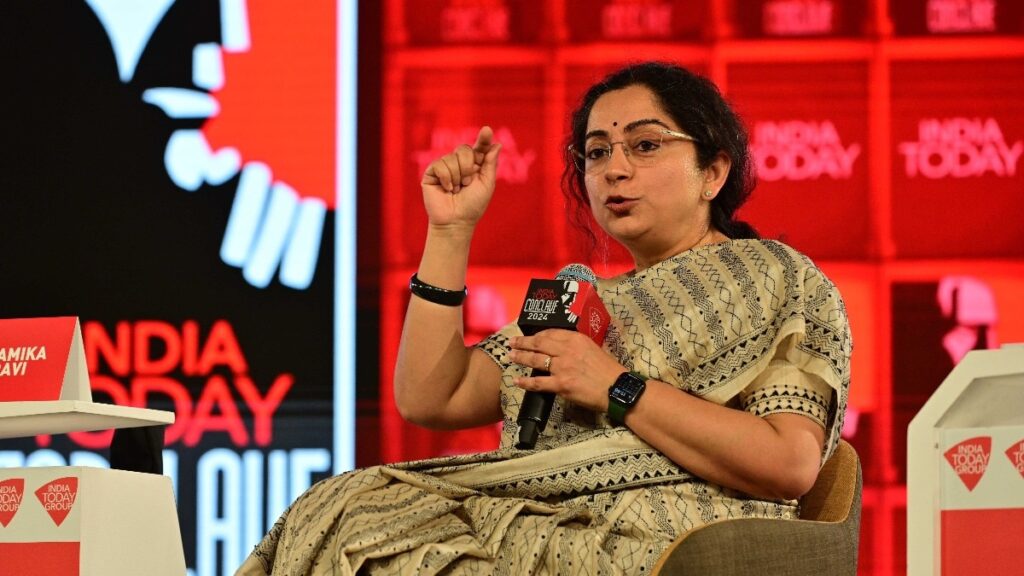Dr Shamika Ravi, a Member of the Economic Advisory Council to the Prime Minister, has said that the drop in the fertility rate among Muslims does not mean that demographic change is not happening in the country. She explained that as long as there is a difference in growth, regardless of the level, the share of one will increase and the share of the other will decrease.
“The fertility rates of the different religions are different. The only thing we hear about is that the fertility rate of the Muslim population is declining faster. Yes, it is declining faster. That is arithmetically the fact, but that does not change things on the ground and that is not even the issue. The real concern is shares of the population within a district,” Ravi said in a conversation with ANI Editor Smita Prakash.
In May last year, the Economic Advisory Council to the Prime Minister (EAC-PM) came out with a paper that showed the share of the Hindu population in India decreased by 7.82 per cent between 1950 and 2015, while that of the Muslims saw a 43.15 per cent jump in the same period.
“In India, the share of the majority Hindu population decreased by 7.82 percent between 1950 and 2015 (from 84.68 percent to 78.06 percent). The share of the Muslim population in 1950 was 9.84 percent and increased to 14.09 percent in 2015 — a 43.15 percent increase in their share,” states the working paper, Share of Religious Minorities: A Cross-Country Analysis (1950-2015), authored by Shamika Ravi, Apurv Kumar Mishra and Abraham Jose.
Ravi said that the council conducted the study because it wanted to see what was happening to the relative share of minorities in India vis a vis other countries of the world. So it’s really a cross-country study for 169 countries from 1950-2015. “We find that in Africa, 22 nations used to be Animism. The majority religion was Animism in 22 countries of Africa. Today, it is zero. None of them are animists because fundamentally they’ve all converted to Christianity or Islam. So conversion is driving a lot of minority the way we define for many parts of the world.”
The noted economist referred to a sharp rise in minority shares in Western Europe and said that it can’t be due to only fertility. In many of the Western European countries, minority shares have increased largely driven by migration because the changes are 30-35%, she said, adding that this massive change is not going to happen only through fertility.
Ravi said that demographic change has a direct bearing on politics, the way institutions are run, the way one spends money, and fiscal policies. India is more like the Western democracies where the share of the minority is actually growing, she added. “That is the larger lesson from that paper. we are the only country where the majority is shrinking and minority share is increasing.”
“When an NGO will go out and say ‘oh but the fertility is declining’, I’m sorry fertility is not the only driver. The kind of growth you have seen cannot be sustained only by fertility. Fertility is a factor but beyond that, conversion. The kind of changes you have seen in Tamil Nadu, in most parts of Northeast. Arunachal Pradesh used to be a Buddhist majority till 2001, in 2011 it’s a Christian majority. If you look at what is happening in Assam, West Bengal many parts of Western UP, Northern Kerala, and Southern Karnataka…there is differentials infertility, there is conversion and there is migration.”
According to the economist, no matter how fast the fertility is decreasing that does not determine the share. “The share is determined by the relative growth of the two. And as long as there is a difference in growth, regardless of the level, the share of one will increase and the share of the other will decrease.”
Ravi dismissed claims that political narratives drive demographic shifts, asserting that the reverse is true. “It’s not the politics of Modi or Rahul Gandhi that’s causing these changes. It’s the ground realities—identity, migration, fertility—that drive politics. Every campaign, every political utterance reflects what’s happening on the ground.”
After the study was published, she said, she faced pushback from only academia and that to from people from the previous establishment who did not want to look at these data points. “They’re uncomfortable because these are hard facts they don’t want to face. Let’s recognize that because demographic changes are glacial, they are really slow but they’re happening. The politics is changing day to day so let’s not even for a while delude ourselves into saying that it’s the politics which is driving changes of demography and religion. No, it’s the other way around.”
Source:https://www.businesstoday.in/india/story/arunachal-was-a-buddhist-majority-but-now-pm-modis-top-advisor-debunks-fertility-decline-myths-in-india-462064-2025-01-26?utm_source=rssfeed

